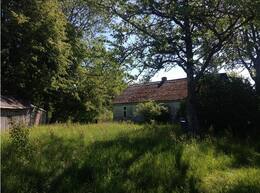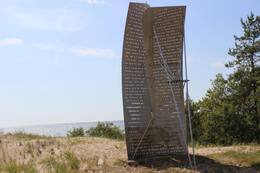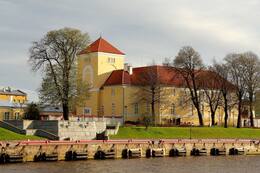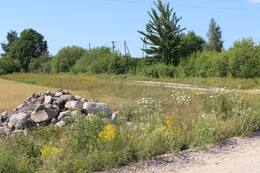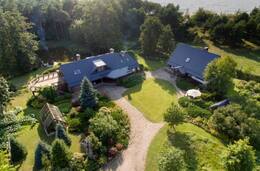The last birthday celebration of Kārļis Skalbes on the coast of Kurzeme
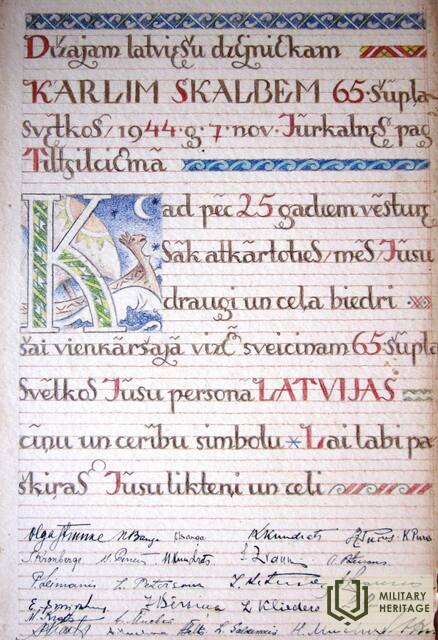
1944. gada 7. novembrī gaišu noskaņu latviešu bēgļu apmetnē Kurzemes piekrasē ienesa dzejnieka Kārļa Skalbes 65. dzimšanas dienas atceres Jūrkalnes “Laukgaļos”. Tikai četras dienas vēlāk Kārlis Skalbe devās ar laivu uz Zviedriju bēgļu gaitās. Tā bija diena, kad Kārlis Skalbe pēdējo reizi svinēja savu dzimšanas dienu.
“Bēgļu pelēkā ikdienā neaizmirstams, gaišs pārdzīvojums bija dzejnieka Kārļa Skalbes 65. dzimšanas dienas atceres Jūrkalnes “Laukgaļos”. Gleznotājs Niklāvs Strunke jau “Grīniekos” bija sācis gatavot adresi dzejnieka 65. jubilejai 7. novembrī. Viņa darbs nebija viegls – mazas, tumšas zvejnieku istabiņas, un vienmēr apkārt kustība, drūzma, troksnis. [..] 7. novembra dienā visa bēgļu saime gan individuāli, gan pulciņos apciemoja skaisto rotu kalēju Latvijai – lielo dzejnieku Kārli Skalbi. Netika pasniegtas vērtīgas davanas, kā dažkārt citos apstākļos tas būtu noticis un pienāktos, netika teiktas cildinošas runas, tomēr katrs sveicējs aiznesa lielajam meisaram savu latvieša sirds siltumu un kādu bēgļu ikdienas vajadzībām derīgu sīkumu. Slimajam dzejniekam (viņš slimoja ar nierēm) ar sievu, meitu, znotu un mazdēlu Andreju “Laukgaļos” bija atsevišķa maza istabiņa. Rudens vakaru tumsu kliedēja tikai kāds sveces galiņš. Kāds inženieris ar agronomu kopīgi bija kā dāvanu atnesuši pudeli petrolejas”.
F. J. Šteinmanis. Ventspils sakaru grupa - “Zviedru laivas”. Ventspils 700. Rakstu un atmiņu krājums, Toronto, 1990, 126. lpp.
Saistītās laikalīnijas
Saistītās tēmas
Saistītie objekti
"Laukgaļi" house, writer Kārlis Skalbe's place of residence
"Laukgaļi" in Jūrkalne parish, the writer Kārlis Skalbe's place of residence in October-November 1944, while waiting for the refugee boat to Sweden.
Memorial sign for refugees "Sail of Hope" in Jūrkalne
The "Sail of Hope" commemorative sign for the World War II refugees who crossed the Baltic Sea by boat to the island of Gotland in Sweden in 1944 and 1945. The memorial is located in Osvalki on the dunes between the sea and Ventspils-Liepaja highway, near the public transport stop "Kaijas". It was created by sculptor Ģirts Burvis, who realised it as a sail of hope symbolising the memory of Latvian refugees.
Between autumn 1944 and spring 1945, fearing the renewed Soviet occupation but unwilling to evacuate to a devastated and threatened Germany, some Latvian citizens tried to reach the nearest neutral country, Sweden, by sea. Some of the boats were organised by the Latvian Central Council with the help of the Western Allied countries, which resulted in one of the largest refugee concentration points in Jūrkalnes parish. Besides the boats organised by the Latvian Central Council, other boats were also taken across the sea. It is estimated that about 5000 persons managed to cross the sea. The number of deaths is unknown, as no records were kept of refugees leaving the Kurzeme coast.
The voyages were dangerous because the refugees were threatened by German patrols on the coast and at sea, sea mines, Soviet aircraft and warships, as well as storms, as the crossings often took place in unsuitable and overloaded cutters and boats without sufficient fuel and food supplies, sea charts and navigational instruments. Departures from Latvia were carried out in secret. The destination of the boats was the island of Gotland, and the journeys most often started on the west coast of Courland (from Jūrkalne to Gotland is 90 nautical miles or about 170 kilometres as the crow flies).
Prison in the castle of the Livonian Order during World War II
1944-1945 in the prison set up in Livonia Oden Castle. In 2010, several members of the LCP Ventspils communication group and the movers of refugee boats were detained.
The road to "Grīnieku" houses in Vārve parish
The road to the "Grīnieku" house in Vārve parish, where in 1944 there was one of the main settlements of boat refugees on the coast of Kurzeme.
Memorial sign for refugees "Sail of Hope" in Jūrkalne
The "Sail of Hope" commemorative sign for the World War II refugees who crossed the Baltic Sea by boat to the island of Gotland in Sweden in 1944 and 1945. The memorial is located in Osvalki on the dunes between the sea and Ventspils-Liepaja highway, near the public transport stop "Kaijas". It was created by sculptor Ģirts Burvis, who realised it as a sail of hope symbolising the memory of Latvian refugees.
Between autumn 1944 and spring 1945, fearing the renewed Soviet occupation but unwilling to evacuate to a devastated and threatened Germany, some Latvian citizens tried to reach the nearest neutral country, Sweden, by sea. Some of the boats were organised by the Latvian Central Council with the help of the Western Allied countries, which resulted in one of the largest refugee concentration points in Jūrkalnes parish. Besides the boats organised by the Latvian Central Council, other boats were also taken across the sea. It is estimated that about 5000 persons managed to cross the sea. The number of deaths is unknown, as no records were kept of refugees leaving the Kurzeme coast.
The voyages were dangerous because the refugees were threatened by German patrols on the coast and at sea, sea mines, Soviet aircraft and warships, as well as storms, as the crossings often took place in unsuitable and overloaded cutters and boats without sufficient fuel and food supplies, sea charts and navigational instruments. Departures from Latvia were carried out in secret. The destination of the boats was the island of Gotland, and the journeys most often started on the west coast of Courland (from Jūrkalne to Gotland is 90 nautical miles or about 170 kilometres as the crow flies).
"Bambaļi" houses - one of the main places of accommodation for boat refugees
The restored "Bambaļi" houses in Ošvalki, Jūrkalne parish, were one of the main places of settlement for boat refugees on the coast of Kurzeme.





